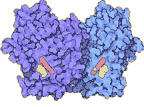When size matters
As you may have noticed, scientists like to measure things. Not just anything they can get their hands on, but also lots of things that are too big to get their hands on, and lots of things that are too small. For example:
too big |
too small |
rainforests
solar systems galaxies universes |
grains of pollen
E. coli enzymes carbon atoms electrons |
What ends up happening is that we need a lot of zero's to express these sizes. For example:
# stars in our galaxy = 100,000,000,000 (roughly)
distance from here to the edge of the universe:
94,608,000,000,000,000,000,000 km (roughly!)
The problem is just as bad when we talk about small things:
diameter of a red blood cell = 0.000007 m
mass of a carbon atom = 0.0000000000000000000000199 grams
Obviously these are numbers that are hard to deal with. A red blood cell with a diameter of 0.00007 m instead of 0.000007 m would be 10 times too big to fit through a capillary, yet it's hard to tell the numbers apart by looking at them - and hard to remember how many zeros there are supposed to be in the first place!
Of course one solution to this problem is to use specialized units. For example, we usually talk about the size of the universe in lightyears, while we express the size of a red blood cell in micrometers. However, these different units make it hard to compare the sizes of things.
Copyright University of Maryland, 2007
You may link to this site for educational purposes.
Please do not copy without permission
requests/questions/feedback email: mathbench@umd.edu
 planets
planets  blood cells
blood cells